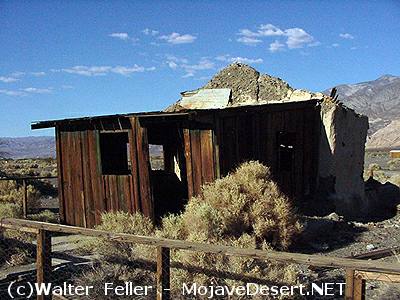Inyo County: Gold in Inyo County
Ballarat Ghost Town
Charles Anthony and John Lampier located the Panamint Valley Mine on July 27, 1893. This mine, also known as the Anthony, Gold Bug, and Knob Mine,
is located 3-1/2 miles east of the
Post Office Spring
in Post Office (now Pleasant) Canyon. A small camp sprang up around Anthony's 5 gold mining
claims. Henry Ratcliff worked in Anthony's camp and discovered in May and July, 1896,6 claims east of town which became the Ratcliff (Radcliffe)
Consolidated Gold Mines, Ltd. James F. Cooper staked a claim east of the Ratcliff group in 1896, near an old stone corral thought to be built
by Indians.
The 80 acre townsite of Ballarat was laid out in 1897, and the buildings from the Ratcliff Mine were hauled down the canyon to help start the
town. George Riggins is credited with suggesting the name Ballarat, after the famous mining town of his native Australia. John S. Stoker, a
storekeeper, was appointed postmaster of Ballarat July 21, 1897. Richard Decker, who once tried reviving Panamint in the 1880s, was appointed
justice of the peace. The two-story Calloway Hotel was built in 1898. A school operated out of an adobe building at Ballarat for one year
in 1899. That same year six saloons were opened for business. In 1900 the Porter brothers built a jail at Ballarat for the Inyo County Board
of Supervisors at a cost of $300. The Teagle brothers opened a feed and supply yard in 1901.73
The total production for the Ratcliff mines have been estimated from $300,000 to $1,000,000. In 1903 a 3,800-foot tram transported ore from the
mines to the mill. An assay office, engine room, blacksmith shop, and various other buildings formed a small camp at the base of the mountain. In
1951, remains at the Ratcliff Mine included a twenty-stamp mill, a 4-foot by 6-foot ball mill, and 4,000 feet of underground workings.
The World Beater, discovered by
Shorty Harris,
began real production shortly after the Ratcliff mines gave out in 1903. According to D. H. Claire,
it produced $185,000 prior to 1930 and another $75,000 from 1936-1942. The Buster Brown, adjoining the World Beater, had a small
five-stamp mill
and its 1927-1942 production amounted to $250,000. The Lotus, and the Monte Cristo mines, 15 miles south of Ballarat, were developed probably
after 1900 by two aerial trains and a 2,800 foot inclined rail tram. A 1,750 foot aerial tramway that serviced the Anthony, Gold Bug, and Knob
mines was rebuilt in l940.74
The Ballarat Post Office was closed on September 29, 1917. Since then Ballarat has been a favorite gathering place for many of the colorful
prospectors and desert residents. Charles Ferge, better known as "Seldom Seen Slim" was one such character to permanently inhabit Ballarat,
and there are other residents today.75
